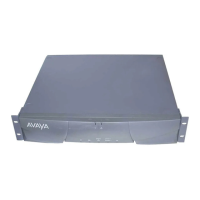Maintenance Object Repair Procedure
555-233-142
8-1178 Issue 1 May 2002
Port Networks with a Single Tone-Clock
Circuit Pack
This procedure is destructive.
1. Pull out the defective IPSI circuit pack. This will remove the clocks and
cause the system to activate emergency measures. Use the busyout
ipserver-interface command:
■ All calls to and from the EPN will drop, and the EPN will activate
Emergency Transfer within about one minute. But the rest of the
system should operate normally.
2. Insert a new IPSI circuit pack. The system will detect the return of the
clocks and will automatically recover as follows:
■ The system will reset the EPN (EPN cold restart), and all of the
EPN’s red LEDs will come on and go off within 30 seconds.
3. If the red LEDs come on but do not go off within 30 seconds, pull the circuit
pack out and reseat it. If the LEDs perform as expected this time, continue
with step 6. Otherwise, there may be a problem with the TDM bus;
possibly a bent pin in the IPSI circuit pack’s slot. Follow the directions in
the TDM-BUS maintenance section.
4. If the red LEDs did light, as explained above, then go to Step 6. If the red
LEDs do NOT light, as explained above, then go on to Step 5.
5. Restart the affected port network:
■ In an EPN, restart the EPN by resetting its Expansion Interface
circuit pack via the reset port-network PN# level 2 command,
using the port network’s number of the affected EPN. (Use the list
cabinet UU command to determine the port network’s number for a
given cabinet and carrier.)
6. Test the new IPSI circuit pack to verify that it is functioning properly, using
the test tone-clock UUC long command, and verify that the system is
operational by placing several phone calls. Where possible, try calls into,
out from, and within the affected port network.
IPSI/Tone Clock LED States
There are four LEDs on the IPSI’s faceplate. The top three LEDs are the standard
ones found on any TN circuit pack. The fourth LED imitates the TN2182B
Tone-Clock’s amber LED.
The active state of an IPSI circuit pack may also be determined by looking at its
LEDs. A continuously lit red LED on the circuit pack indicates a reported fault on
one or more of its MOs. Flashing patterns of the yellow and green LEDs
correspond to the following service states:

